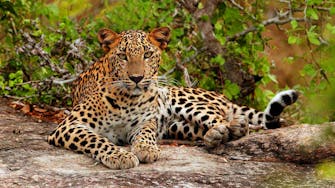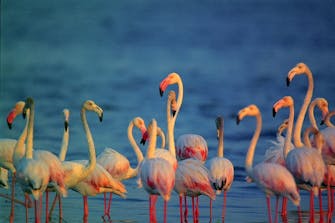Despite its small size Sri Lanka boasts one of the highest rates of biological endemism in the world in plant or animals, and is included among the top biodiversity hotspots in the world. While Asian elephants, sloth bears, leopards, sambar and wild buffaloes draw the major attention of visitors, there are many less know species waiting to be discovered.
Although less celebrated, Sri Lanka has one of the richest diversity of amphibians in the world, containing around 106 species. A high concentration of these found in the nearby Sinharaja rainforest.
Despite the mighty elephants and rare amphibians, birds are the gems of Sri Lanka’s wildlife. Boasting around 433 species, with 26 endemic species.
We can arrange safaris and tours to these parks and sanctuaries if you like.
Udawalawe National Park
Udawalawe National Park was created to provide a sanctuary for wild animals displaced by the construction of the Udawalawe Reservoir on the Walawe River, as well as to protect the catchment of the reservoir. Beautifully situated below the hill country, whose grand escarpment provides a memorable backdrop to the dominant plains topography, Udawalawe lies on the boundary of the wet and dry zone. The reserve covers 30,821 hectares of land area and is an important habitat for water birds and Asian elephants. It is a popular tourist destination and the third most visited park in the country thanks to its easily spotted population of elephants, around 600. There are also hundreds of buffaloes, plus macaque and langur monkeys, spotted and sambar deer and crocodiles. Other less sighted residents include leopards, giant squirrels, jungle cats, sloth bears and porcupines. The reservoir also attracts a wide range of birds including the unmistakable Lesser Adjutant, Sri Lanka’s largest bird.
You can combine this with a visit to the Elephant Transit Home.
Distance from Villa: 101km, 2.75hr
Yala national park
Yala is the most visited and second largest national park in Sri Lanka. The park covers 979 square kilometres and along with Wilpattu was one of the first two national parks in Sri Lanka, having been designated in 1938. The park is best known for its variety of wild animals and having one of the highest densities of leopard in the world.
Situated in the dry semi-arid climatic region, rain is received mainly during the northeast monsoon. However it hosts a variety of ecosystems ranging from moist monsoon forests and both fresh and marine wetlands.
44 species of mammals are resident in the park, including around 350 Asian elephants, sloth bears, fishing cats, wild water buffalo, monkeys, golden palm civet, toque macaque, saltwater and mugger crocodiles, red slender loris and four types of mongoose. The best time to spot leopards, elephants and sloth bears is February to July when water levels in the park are low.
Yala also harbours 215 bird species and is considered one of the seventy important bird areas in Sri Lanka.
Distance from the Villa: 135km, 3hr
Turtle Hatchery
Visit the turtle hatchery where transplanted eggs are hatched and the baby turtles are then released into the sea. Find out all about the various species of turtles found in Sri Lankan waters.
Distance from Villa: 30km, 1hr
To visit their website click here
Snake Farm/Conservation centre
It is worth the 30 minute drive to look into the history of this Ayurvedic family that has done a lot to cure people from snake bites. This isn’t really a snake farm but more a conservation centre.
The family have owned the property for 200 years and it was started by the current proprietor’s grandfather and aims to offers free herbal medicines to combat snake bites.
Distance from Villa: 16km, ½ hour
To see more on trip advisor click here
Sinharaja Forest Reserve
Sinharaja Forest Reserve is a national park and a biodiversity hotspot in Sri Lanka. It is of international significance and has been designated a Biosphere Reserve and World Heritage Site. The hilly virgin rainforest was saved from the worst of commercial logging by its inaccessibility. The reserve is only 21 km from east to west, and a maximum of 7 km from north to south, but it is a treasure trove of endemic species, including trees, insects, amphibians, reptiles, birds and mammals.
Because of the dense vegetation, wildlife is not as easily seen as at dry-zone national parks such as Yala. There are about 3 elephants and the 15 or so leopards are rarely seen. The most common large mammal is the endemic purple-faced langur. Of Sri Lanka’s 26 endemic birds, the 20 rainforest species all occur here, including the elusive red-faced malkoha, green-billed coucal and Sri Lanka blue magpie. Reptiles include the endemic green pit and hump nosed vipers, and there are a large variety of amphibians, especially tree frogs.
Distance from the Villas: 78km, 2.5hr
Bundala National Park
Bundala National Park is an internationally important wintering ground for migratory water birds in Sri Lanka. Bundala harbors 197 species of birds, the highlight being the greater flamingo, which migrate in large flocks. A few Asian elephants still inhabit the forests of Bundala while other mammals seen in the park are toque macaque, common langur and jackal
Bundala was designated a wildlife sanctuary in 1969 and redesignated to a national park on 4 January 1993. In 1991 Bundala became the first wetland to be declared as a Ramsar site in Sri Lanka. In 2005 the national park was designated as a biosphere reserve by UNESCO, the fourth biosphere reserve in Sri Lanka.
Distance from Villa: 96km, 2.5hr
Kalametiya Bird sanctuary/lagoon.
Located twenty km past Tangalle is the nature sanctuary with coastal lagoon, mangroves and birds. Local guides will take you on an excellent evening tour from 3.30pm until sunset.
For more information click here
Distance from Villas: 65km, 2hr








